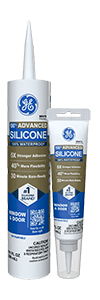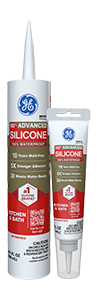Note: This DIY article is provided as a general guide only and is not intended to take the place of product-specific installation procedures; always follow applicable manufacturers’ instructions. Depending on your home’s age and condition, location within the home, and other potential factors, repairs and/or upgrades or other services may be necessary prior to the beginning and/or completion of your project that may involve the services of a home improvement professional. This article does not include advice pertaining to local building codes and/or any related inspections.
Understanding what to look for when checking if your sealant has expired can save you a lot of grief. Our guide on “Does sealant expire?” will explain why sealants expire and provide 5 pro tips to ensure you never use expired sealants again.
Does sealant expire?
Silicone sealants have a shelf life, after which they expire and become less effective. The shelf life varies between brands, with most expiring after a year. As such, a tube of sealant, even when unopened, will expire after around a year from the date of manufacture. Some silicone sealants, such as the Advanced Silicone 2 Kitchen & Bath Sealant from GE Sealants, have a shelf life of 18 months.
The best silicone brands include a sealant expiration date on the tube. While some brands offer straightforward information, others use a code that may require you to contact the manufacturer. The use-by date on GE sealants are printed on the crimping of the squeeze tube or on the cartridge.
With proper storage, silicone sealant will retain its efficiency throughout its lifespan. Since they’re moisture-curing, silicone sealants are highly susceptible to environmental factors such as humidity, temperature, and air exposure. Therefore, improper storage may lead to reduced effectiveness, premature curing, and spoilage.
- Temperature: Extreme heat and cold temperatures may cause the sealant to degrade, ruining its consistency. To keep your sealant in the best condition, store it in a cool, dry place between 40 °F and 80 °F.
- Air exposure: The curing process begins once you expose a silicone sealant to air. If air leaks into the sealant cartridge, the sealant starts to cure — it hardens and renders the product useless.
- Moisture: While silicone sealants have exceptional moisture resistance, they may combine with moisture while still in the tube. Exposing the sealant’s tube to water, excessive moisture, or humidity may cause the sealant to cure prematurely.
- Sun exposure: While silicone sealants have UV-resistant formulations, prolonged exposure of the tube to the sun leads to degradation. Storing cartridges away from direct sunlight helps prolong the sealant’s shelf life.
Because of their chemical makeup, silicone sealants have a limited shelf life. Over time, the chemical components break down and lose their effectiveness. Plasticizers, crosslinking agents, heat stabilizers, and UV absorbers may separate or evaporate, rendering the sealant ineffective.
5 signs that it's time to replace your sealant
Contractors often prefer shopping for silicone in bulk for convenience and cost savings. Shopping in bulk ensures a smooth workflow since you’re not worried about stockouts when working on a critical project. However, buying in bulk carries a significant downside — a portion of your silicone sealant batch may expire.
To avoid compromising the quality of your work, you should learn how to tell if a sealant is expired. Using an expired silicone sealant batch may deliver subpar results and cause you or your client to incur extensive losses.
How to tell if sealant is expired with 5 telltale signs:
-
Past expiry date:
Check your tube for the sealant expiration date — the sealant is likely expired if the sell-by date has already passed. Depending on the brand, you may find this information printed at the bottom of the sealant tube or on the crimping — where the plunger meets the tube. Some brands use the date of manufacture, others prefer the best-before dates. Some manufacturers use codes, while others fail to include this information. If in doubt about a silicone sealant’s expiry date, check the manufacturer’s website for their product’s shelf life or information to decipher their code. If all else fails, call their customer service desk for clarification.
-
Inconsistent texture:
Your silicone sealant has gone bad if it is runny or has separated into different layers within the tube. The inconsistency indicates a breakdown in the sealant’s chemical components. The silicone polymer chains may have separated from the plasticizers, fillers, coupling agents, and other additives responsible for the exceptional sealing capabilities. We recommend discarding the sealant using a fresh tube and ensuring the sealant has a gel-like consistency.
-
Hardened sealant inside the tube:
A silicone sealant may cure and harden if the tube is exposed to air and moisture. Hardened sealant won’t flow from the tube no matter how hard you push the plunger of the sealant gun. You will likely face this problem if you leave a partially used silicone tube for too long or improperly stored. If you seal and store it properly, you can preserve unused sealant in an opened tube for future use. We recommend pushing the sealant until some oozes out of the nozzle, then taping the nozzle with aluminum foil or plastic wrap. That eliminates the air inside the cartridge and creates an airtight seal to prevent curing.
-
Unrealistic cure time:
Ideally, silicone sealants cure within 24 hours. You’re likely using an expired sealant if it doesn’t skin within 30 minutes or cure fully even after several days. The sealant should be dry to the touch within an hour of application. However, the curing periods vary between brands. The Supreme Silicone Kitchen & Bath Sealant from GE Sealants is water-ready within 30 minutes of application.
-
Deteriorating seals:
Quality silicone sealants create durable seals that last for years. If you notice gaps, cracks, or deteriorating seal appearance over time, you may have used an expired silicone sealant.
If you mistakenly use expired silicone sealant to waterproof your bathroom, it will likely not harden within half an hour and may remain uncured . At this point, you may wonder if the expired sealant will ever cure. Unfortunately, the chemical breakdown is irreversible, so the sealant won’t harden and cure, even if you leave it for weeks. You may need to strip the spoiled batch and reapply it to reap silicone sealants’ reliable, quick-drying benefits.
You may find yourself in a difficult position if you have a large batch of unused but expired sealant in stock. You may wonder, “Can I use out-of-date silicone sealant?” to avoid huge losses. Unfortunately, using expired silicone is a recipe for disaster. First, the sealant may fail to cure, and if it does, the seal may fail rather quickly, especially when used in wet areas such as the bathroom or a basement. As such, you or your client may face the risk of water damage and mold infestation, which may cost more time, effort, and money to fix. Regularly investing in new sealant keeps your stash top-quality so you can seal every project to perfection.
Silicone sealants have a shelf life to help you seal each project to perfection. GE Sealants have extended shelf life, up to 18 months, to ensure you get value for your money. Find a store near you!



